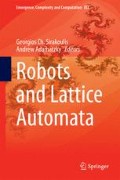Abstract
Self-reconfigurable robots are built from robotic modules typically organised in a lattice. The robotic modules themselves are complete, although simple, robots and have onboard batteries, actuators, sensors, processing power, and communication capabilities. The modules can automatically connect to and disconnect from neighbour modules and move around in the lattice of modules. The self-reconfigurable robot as a whole can, through this automatic rearrangement of modules, change its own shape to adapt to the environment or as a response to new tasks. Potential advantages of self-reconfigurable robots are extreme versatility and robustness. The organisation of self-reconfigurable robots in a lattice structure and the emphasis on local communication between modules mean that lattice automata are a useful basis for control of self-reconfigurable robots. However, there are significant differences which arise mainly from the physical nature of self-reconfigurable robots as opposed to the virtual nature of lattice automata. The problems resulting from these differences are mutual exclusion, handling motion constraints of modules, and unrealistic assumption about global, spatial orientation. Despite these problems the self-reconfigurable robot community has successfully applied lattice automata to simple control problems. However, for more complex problems hybrid solutions based on lattice automata and distributed algorithms are used. Hence, lattice automata have shown to have potential for the control of self-reconfigurable robots, but still a unifying implementation based on lattice automata solving a complex control problem running on physical self-reconfigurable robot is yet to be demonstrated.
Access this chapter
Tax calculation will be finalised at checkout
Purchases are for personal use only
Notes
- 1.
http://modrobotics.com, [Online], retrieved 28/1/2013.
References
Bojinov, H., Casal, A., Hogg, T.: Emergent structures in modular self-reconfigurable robots. In: Proceedings of IEEE International Conference on Robotics and Automation, vol. 2, pp. 1734–1741. San Francisco, California (2000)
Bojinov, H., Casal, A., Hogg, T.: Multiagent control of self-reconfigurable robots. In: Proceedings of 4th International Conference on MultiAgent Systems, pp. 143–150. Boston, Massachusetts (2000)
Butler, Z., Kotay K., Rus, D., Tomita, K.: Cellular automata for decentralized control of self-reconfigurable robots. In Proceedings of IEEE International Conference on Robotics and Automation, Workshop on Modular Self-Reconfigurable Robots. Seoul, Korea (2001)
Butler, Z., Kotay, K., Rus, D., Tomita, K.: Generic de-centralized control for lattice-based self-reconfigurable robots. Int. J. Robot. Res. 23(9), 919–937 (2004)
Butler, Zack, Rus, Daniela: Distributed planning and control for modular robots with unit-compressible modules. Int. J. Robot. Res. 22(9), 699–715 (2003)
Christensen, D.J.: Experiments on fault-tolerant self-reconfiguration and emergent self-repair. Proceedings. Symposium on Artificial Life part of the IEEE Symposium Series on Computational Intelligence, pp. 355–361. Honolulu, Hawaii (2007)
Fukuda, T., Kawauchi, Y., Buss, M.: Self organizing robots based on cell structures—CEBOT. In: Proceedings of IEEE/RSJ International Workshop on Intelligent Robots and Systems, pp. 145–150 (1988)
Fukuda, T., Nakagawa, S.: Dynamically reconfigurable robotic system. In: Proceedings of IEEE International Conference on Robotics and Automation, vol. 3, pp. 1581–1586 (1988)
Fukuda, T., Ueyama, T.: Cellular Robotics and Micro Robotics Systems, vol. 10 of World Scientific Series in Robotics and Autonomous Systems, vol. 10. World Scientific (1994)
Murata, S., Kurokawa, H.: Self-Organizing Robots. Springer, New York (2012)
Murata, S., Kurokawa, H., Kokaji, S.: Self-assembling machine. In: Proceedings of IEEE International Conference on Robotics and Automation, pp. 441–448. San Diego, California (1994)
Østergaard, E.H., Lund, H.H.: Evolving control for modular robotic units. Proceedings of IEEE International Symposium on Computational Intelligence in Robotics and Automation, pp. 886–892. Kobe, Japan (2003)
Østergaard, E.H., Lund, H.H.: Distributed cluster walk for the ATRON self-reconfigurable robot. In: Proceedings of 8th Conference on Intelligent Autonomous Systems, pp. 291–298. Amsterdam, Holland (2004)
Romanishin, J.W., Gilpin, K., Rus, D.: M-blocks: Momentum-driven, magnetic modular robots. Proceedings of IEEE/RSJ International Conference on Intelligent Robots and Systems, pp. 8288–4295. Tokyo, Japan (2013)
Rosa, M.D., Goldstein, S., Lee, P., Campbell, J., Pillai, P.: Scalable shape sculpting via hole motion: Motion plan- ning in lattice-constrained modular robots. In: Proceedings of IEEE International Conference on Robotics and Automation, pp. 1462–1468, Orlando (2006)
Støy, K.: Controlling self-reconfiguration using cellular automata and gradients. In: Proceedings of 8th International Conference on Intelligent Autonomous Systems, pp. 693–702. Amsterdam, The Netherlands (2004)
Stoy, K., Brandt, D.: Efficient enumeration of modular robot configurations and shapes. In: Proceedings of IEEE/RSJ International Conference on Robotics and Intelligent Systems, pp. 4296–4301. Tokyo (2013)
Stoy, K., Christensen, D.J., Brandt, D.: Self-Reconfigurable Robots: An Introduction. MIT Press (2010)
Varshavskaya, P., Kaelbling, L.P., Rus, D.: Automated design of adaptive controllers for modular robots using reinforcement learning. Int. J. Robot. Res. 27(3–4), 505–526 (2008)
Walter, J., Welch, J., Amato, N.: Concurrent metamorphosis of hexagonal robot chains into simple connected configurations. IEEE Trans. Robot. Autom. 18(6), 945–956 (2002)
Author information
Authors and Affiliations
Corresponding author
Editor information
Editors and Affiliations
Rights and permissions
Copyright information
© 2015 Springer International Publishing Switzerland
About this chapter
Cite this chapter
Stoy, K. (2015). Lattice Automata for Control of Self-Reconfigurable Robots. In: Sirakoulis, G., Adamatzky, A. (eds) Robots and Lattice Automata. Emergence, Complexity and Computation, vol 13. Springer, Cham. https://doi.org/10.1007/978-3-319-10924-4_2
Download citation
DOI: https://doi.org/10.1007/978-3-319-10924-4_2
Published:
Publisher Name: Springer, Cham
Print ISBN: 978-3-319-10923-7
Online ISBN: 978-3-319-10924-4
eBook Packages: EngineeringEngineering (R0)

